Modest But Fully Realized Burgundy: A Producer’s Quest For Authenticity and Identity in Côte d’Or’s Most Northerly Commune: Marsanny (6-Bottle Pack $281)
Within Burgundy’s hierarchy, Marsannay is a fairly new invention. The northernmost commune in Burgundy’s heart only achieved Village status in 1987; prior to that, its grapes were restricted to use in regional wine. Suffice to say that the growing pains of such a phenomenon may take decades, and to date, Marsannay contains none of the storied Grand or Premier Crus in the carefully delineated Burgundy classification system.
And this is good news for bargain hunters. In Burgundy most emphatically, wine prices are set on reputation as much as anything else. As such, Marsannay wines represent unparalleled value, especially since many individual estates have forged new commitments to improve what history and nature has provided.
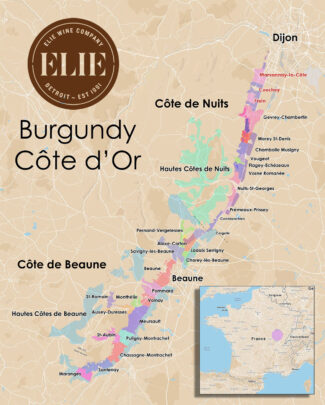
This week’s wine package contains representative examples of this quality surge from a small, family-run winery, Domaine Collotte as well as some additional labels that have produced an ever-improving roster of Marsannay gems.
Marsannay: Modest But Fully Realized Burgundy
Located just above Fixin and Brochon, just beyond the Dijon, Marsannay is composed of three villages—Couchey, Chenove and Marsannay-la-Côte. Of the 514 acres under vine, 445 are planted to red grape varieties (nearly all of it Pinot Noir) and 69 acres are dedicated to white grape varieties, mostly Chardonnay. These vines extend from north to south along the best section of the slope at elevations range from between 830 and 1300 feet, where terroir is a vine-friendly blend of shallow limestone soils, clay and silt.
Marsannay is the only Village-level appellation entitled to produce wines in red, white and rosé, making it a fully-realized Burgundy capable of showcasing the richness of Burgundy’s palette.
The Rehabilitation of Marsannay
Having been offered an upgraded seat in Burgundy’s Villages section, Marsannay has set to work ensuring that it remains worthy of the promotion. Many people still think of it as primarily rosé country, and there is no reason for it to entirely shed this reputation: Marsannay still produces amazing pink wines.
With new status comes heightened responsibilities, and winemakers in Marsannay find themselves with both the need and the means to rehabilitate reputations once maligned in the Côte de Nuits. Beyond technical improvements and state-of-the-art equipment, new theories about working the soil, machines for optical sorting and for pressing and maturing wine, human investments in both field and cellar.
Fight for Recognition: Pinotism Reigns
‘Pinotism’ is a term coined by the great Andrew Jeffords in describing the cult-like affection that Burgundy lovers have for their pet Pinot Noir, a finicky, difficult-to-ripen grape that commands loyalty like no other red wine variety. This phenomenon is due, in part, to the elusive mystery of its rocks-and-roses sensuality and also—paradoxically—because the opposite is also true: Pinot Noir can appear as a sparkling, white, red or rosé; it goes with nearly everything, salmon to steak, which explains its popularity in restaurants.
In Marsannay—a village once known for its Gamay—Pinot Noir is now the most widely planted grape, as integral to rosé (which also contains Pinot Gris and around 10% Chardonnay and Pinot Blanc) as it is to the robust reds of Chenove and Couchey.
Domaine Collotte
Located on Rue de Mazy, Marsannay’s ‘high street’, Domaine Collotte shares a headquarters with Domaine Fougeray de Beauclair, owned by a Collotte cousin. Formerly under the control of Philippe Collotte, his daughter Isabelle—having completed her viticulture studies—has joined her father in the domain and specializes in making the family’s superb Marsannay Blancs.
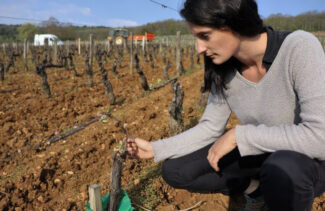
Isabelle Collotte, Domaine Collotte
Isabelle entered the business with plenty to work with: Covering about forty acres, mainly in Marsannay but with small plots in Fixin, Gevrey and Chambolle, Domaine Collotte draws mainly from vines over fifty years old and farms one lieu-dit planted in 1947. Among the innovations she has insisted upon involves selling less wine in bulk, which was a practice of her father.
In addition, she has embraced a holistic view of vineyard work: “Plowing is the norm here, no herbicides,” she says. “The grapes are triaged at the winery before 100% destemming into concrete tanks with one week of cool maceration. We love the thermal stability of concrete so there is a little pigeage early in fermentation and later only remontage. The color is ‘fixed’ with a short period at 35°C where the wine slowly cooling in the tank before a pneumatic press and then into barrels.”
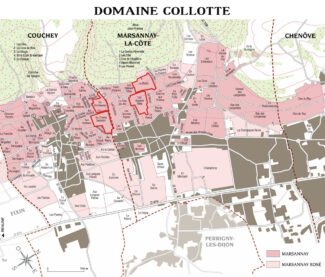
Phillipe adds, “The common thread running through Domaine Collotte is an intimate link, our visceral attachment to Marsannay. For over 100 years, each generation of the Collotte family has dedicated its life to this village and its vineyards. Even if some of our parcels are located in Chambolle-Musigny, Fixin or Gevrey-Chambertin, it is in Marsannay-la-Côte that the heart of Domaine Collotte beats. Clos de Jeu, Champ Salomon, Boivin, Grasses Têtes, Combereau are a few of the Climats de Marsannay that plunge us daily into history by domain that is eminently proud of its roots.”
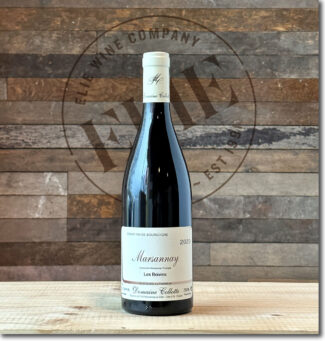 •1• Domaine Collotte, 2020 Marsannay ‘Les Boivins’ ($46)
•1• Domaine Collotte, 2020 Marsannay ‘Les Boivins’ ($46)
Les Boivins is a small lieu-dit that sits at the top of the slope just west of Marsannay where soils are clay and limestone. Boivins is known for sturdier wines than those produced in neighboring climats like Les Longeroies, which is five times its size. This wine comes from vines that are around half a century old. Like most of Domaine Collotte’s vineyard-specific wines, it sees 25% new oak to mellow the tannins and shows notes of blackberry, cherry, vanilla, clove, cedar, sage and earth.
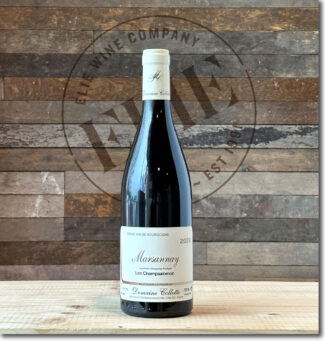 •2• Domaine Collotte, 2020 Marsannay ‘Les Champsalomon’ ($46)
•2• Domaine Collotte, 2020 Marsannay ‘Les Champsalomon’ ($46)
Champsalomon is tiny, only a little over an acre in total, where soils are predominantly limestone and Ostrea Acuminata marl. This 100% Pinot Noir hails from vines that have passed their fiftieth birthday, producing richly concentrated juice resplendent with cherry, spices, licorice and crushed rocks layered toward a powerful, focused finish. Domaine Collotte also produces a Champsalomon Blanc, made in part with Chardonnay Rosé—an extremely rare pink-berried mutation of Chardonnay.
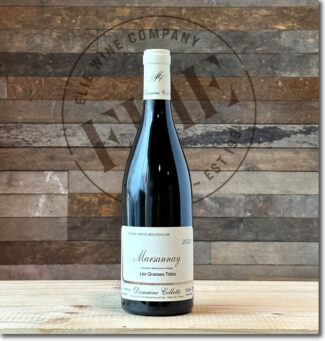 •3• Domaine Collotte, 2020 Marsannay ‘Les Grasses Têtes’ ($46)
•3• Domaine Collotte, 2020 Marsannay ‘Les Grasses Têtes’ ($46)
Les Grasses Têtes (translating to ‘fat heads’ in reference to the large outcroppings of bedrock) is a 20 acre, east-facing lieu-dit that stretches from the houses in the village to the top of the slope, with an average gradient of 10%. With a bit more clay in the otherwise classic limestone soils, these wines are generally a bit more plush and fruit-forward, requiring less cellar age to come into their own. Collotte’s 2020 shows perfumed aromas of cherry preserves, smoky minerals, exotic spices and bacon fat braced by a spine of juicy acidity.
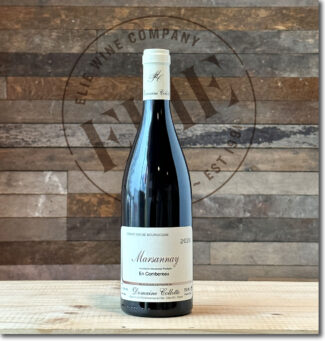 •4• Domaine Collotte, 2020 Marsannay ‘En Combereau’ ($47)
•4• Domaine Collotte, 2020 Marsannay ‘En Combereau’ ($47)
50-year-old vines from the En Combereau climat, where the roots penetrate into a Crinoidal limestone soil atop hard bedrock. The vineyard is tended organically and produces a seductive Pinot Noir with a bouquet of cherry, earth, truffle, and dried mushrooms; soft and silken on the palate, with warm, delicate red fruit, alongside notes of flowers and sweet spice.
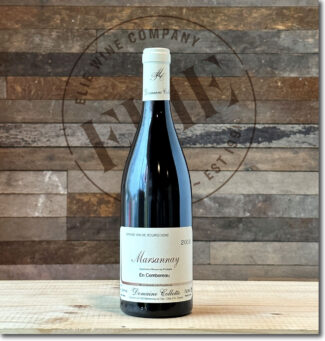 •5• Domaine Collotte, 2018 Marsannay ‘En Combereau’ ($41)
•5• Domaine Collotte, 2018 Marsannay ‘En Combereau’ ($41)
‘En Combereau’ one of the climats in Marsannay expected to eventually become a Premier Cru. This terroir, ideally located mid-slope on clay-limestone soils, produces wines that stand out for their density and depth but also for their elegance. Marked by its Côte de Nuits character, this wine shows an intense nose of blackcurrant, raspberry and undergrowth. Its rounded mouthfeel is shrouded in velvety tannins with a spark of anise on the finish.
Fixin: The Twin Commune
Fixin is the crème in an Oreo cookie formed by Marsannay to the north and Gevrey-Chambertin to the south; it boasts a superb terroir and unlike Marsannay, it contains six Premier Cru vineyards—La Perrière, Clos du Chapître, Arvelets, Clos Napoléon, Le Meix-Bas and Hervelets. Soils are similar, with homogenous brown limestone exploited best in exposures running east to south-east. Some vineyard plots (Hervelets, for example) have more marl, and those wines are predictably heavier and longer-lived.
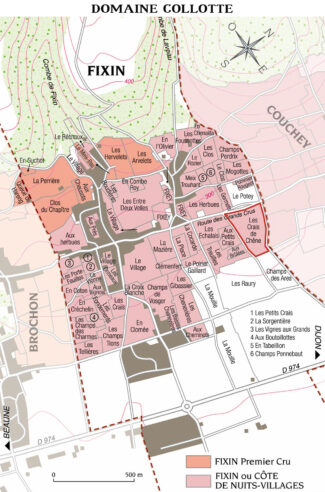
Fixin is solidly red wine country; Pinot Noir accounts for 96% of total production. Chardonnay and Pinot Blanc are also grown in small quantities, whereas Pinot Gris was decommissioned in 2011. Although the legislation permits up to 15% of Chardonnay and Pinot Blanc to be used as accessory grapes in red wines, this is rarely done. The few white wines are generally made entirely of Chardonnay, although blending with Pinot Blanc is permitted. Not much Fixin Blanc makes it out of the appellation; it remains a locally-kept, locally-consumed secret.
Fixin Pinot Noir is often referred to as a ‘winter wine’ because they are rarely ready to drink upon release. Deep purple (‘deep mid-red’ in Burgundian terms), they are floral on the nose with violet and peony at the forefront of the bouquet and currant, cherry and quince on the palate. With bottle-age, they take on animal scents of musk and leather.
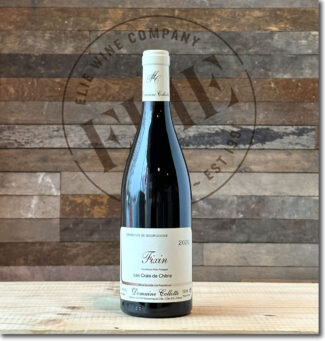 •6• Domaine Collotte, 2020 ‘Cuvée Vieilles Vignes’ Fixin ‘Les Crais de Chêne’ ($55)
•6• Domaine Collotte, 2020 ‘Cuvée Vieilles Vignes’ Fixin ‘Les Crais de Chêne’ ($55)
Crais de Chêne is a four-acre lieu-dit that lies on the alluvial cone between the villages of Couchey and Fixin. The plot is composed of limestone soils mixed with clay, and the vine age is approaching sixty years. Beefy and muscular, the wine shows the pedigree of much pricier Burgundies, with Morello cherry, strawberry, sweet spice and leading to a lingering, mineral-driven finish.
In addition to the above package, some of our favorite producers also have footholds in Marsannay. These wines are available in addition to the above.
Domaine Jean-Michel Guillon & Fils
The pilot of Domaine Guillon & Fils is indeed a pilot: When he first established himself in Burgundy in 1980, he flew planes for the French Navy—neither he, nor anyone in his family, had ever been involved in the wine trade. But he loved Burgundy, so he took an analytical approach and studied what experienced masters in the region did (including Rousseau, Dugat-Py and Denis Bachelet) and built up relationships that ultimately led to his acquisitions of vineyards. Today, the domain covers 35 acres including parcels in the Grand Cru sites of Clos de Vougeot and MazisChambertin. In 2005 his son Alexis joined the business, and today carries forward the family legacy.
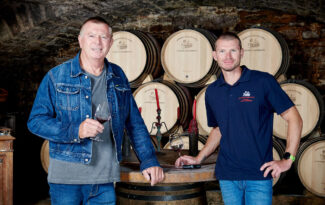
Jean-Michel and son Alexis Guillon, Domaine Jean-Michel Guillon & Fils
He says, “Our goal is to produce succulent wines that retain a clear sense of style and grace while remaining identifiably Pinot Noir. This can only be attained by attention to detail in the vineyard with yields kept low to produce the best fruit, and scrupulous vinification methods using 100% of the finest new oak. This is an approach we carry across the entire range of our wines, including the Marsannay.”
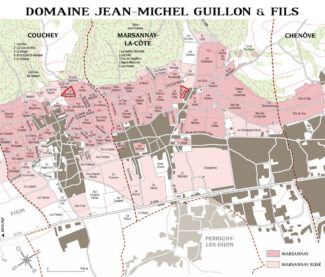
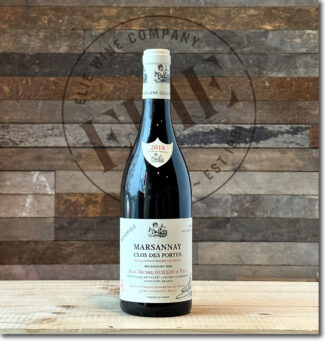 Domaine Jean-Michel Guillon & Fils, 2018 Marsannay ‘Clos des Portes’ Monopole ($64)
Domaine Jean-Michel Guillon & Fils, 2018 Marsannay ‘Clos des Portes’ Monopole ($64)
Jean Michel purchased the entire Clos des Portes lieu-dit in 2005, making it a monopole. Farmed at yields similar to his Grand Crus, it’s said to resemble Gevrey Chambertin before a Marsannay. Either way, it is a delicious and concentrated wine with lovely black raspberry fruit, spice, garrigue and fine nuances of raspberry pulp, lime and hints of hibiscus and jasmine.
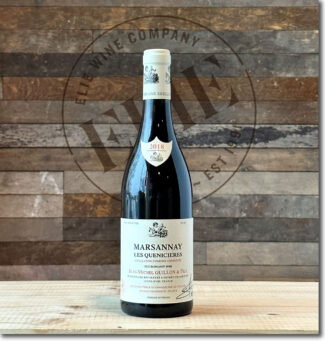 Domaine Jean-Michel Guillon & Fils, 2018 Marsannay ‘Les Quenicières’ ($61)
Domaine Jean-Michel Guillon & Fils, 2018 Marsannay ‘Les Quenicières’ ($61)
A discreet application of wood serves as a backdrop for the pretty plum, violet, earth and slightly gamy aromas; there is a mild touch of austerity to a balanced and refreshing finish. 1,200 bottles made.
Domaine Charles Audoin
Nobody knows the terroir of Marsannay quite like the Audoins. Having worked the soil and sold to négociants for multiple generations, 1972 heralded the year when the domain started bottling its own product. Under the management of Charles Audoin, the Audoin name on the label coincided with the expansion of the holdings from 6 acres to nearly 35.
Charles’s son Cyril took the reins in 2009, but Charles still remains active in the day to day operations, particularly in the vineyards. Cyril chose to keep the domain under his father’s name, as he credits his father with bringing the most change and attention to the property.
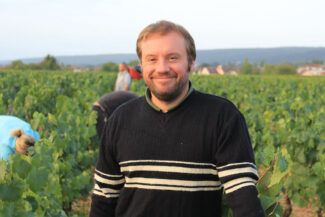
Cyril Audoin, Domaine Charles Audoin
Says Cyril, “Farming at the domain falls under the sustainable lutte raisonnée method, and we farm almost exclusively with organic practices. I have chosen to farm with the environment in mind, and all harvesting is done by hand with selective sorting done at several stages. Our wines are made in a very traditional manner—reds see a varying degree of whole cluster inclusion during ferments, though rarely more than 30%, and in some years, there is no stem inclusion at all. This is dependent on the vintage and ripeness of the fruit and stems. Extractions are on the lighter side, keeping with our focus on allowing the fruit to show the elegance and grace of our terroir. Élevage for all wines is carried out in barrel, mostly neutral but with varying degrees of new oak depending on the cuvée.”
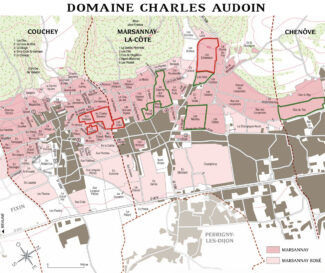
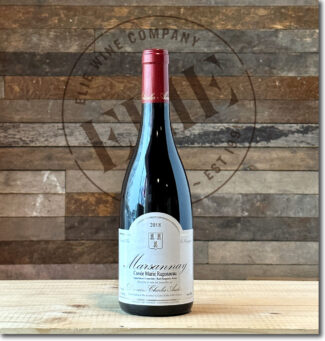 Domaine Charles Audoin ‘Cuvée Marie Ragonneau’, 2018 Marsannay ($48)
Domaine Charles Audoin ‘Cuvée Marie Ragonneau’, 2018 Marsannay ($48)
Named after Cyril’s great-grandmother, the blend originates from several top Audoin old vine parcels—Champs-Salomon, Les Crais, La Pucine, Herbues and Les Echezots. It’s intended as a representation of the village rather than a single vineyard. Tart cherry, cranberry and raspberry weave through a taut mineral core with black pepper and earth notes emerging on a mineral-driven finish.
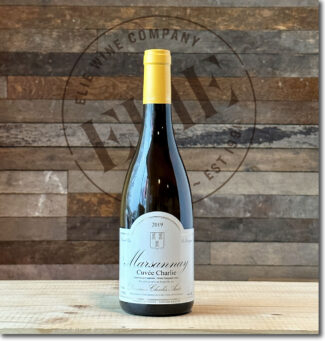 Domaine Charles Audoin ‘Cuvée Charlie’, 2019 Marsannay Blanc ($48)
Domaine Charles Audoin ‘Cuvée Charlie’, 2019 Marsannay Blanc ($48)
100% Chardonnay from Charme aux Prêtres and Clos du Roy, as well as a small portion of grapes from Les Récilles, Le Poiset and Les Crais. The bunches are 100% destemmed and cold macerated, and not crushed during pneumatic pressing in order to preserve the aroma and freshness. The wine then spends a year in 20% new oak barrels from the Vosges and is bottled unfined and unfiltered. The wine shows notes of honeysuckle and citrus while the oak provides a touch of toasted vanilla. The grapes are macerated for 15 days, then transferred to 20% new oak barrels to age for 12 to 18 months and six months in tanks, after which the wine is bottled without fining or filtration.
Vintage Journal
2020: Classical, Expressive with Outstanding Aging Potential
2020 produced Marsannay wines that are, in most descriptions, ‘classical’—a somewhat remarkable result since the season was also considered (in most descriptions) ‘extreme’. Few growers in the Côte de Nuit thought the hot and dry summer—in which many of them completed the entire harvest in August—could possibly produce such fresh and energetic wines. Despite the heat, the ‘crunchiness’ that results from balanced acidity remained quite prominent, and the concentration of the juice in smaller-than-average berries added a nice foil of richness. Among the top producers, tannins remained finely-grained and the wines are delightful in their youth, but capable of considerable improvement over time.
2018: Solar, Voluptuous with Immediate Appeal
In the Côte de Nuit, 2018 proved to be one of the rare vintages that offered both quality and quantity. On the face of it, the season was relatively straightforward; a wet winter and spring topped up the water reserves and the warm, sunny summer ensured the grapes reached ripeness without difficulty. The usual threats of disease, rot, frost and hail barely entered the picture, and harvest took place under blue skies with temperatures in the mid-eighties. That said, the exceptional heat and near-drought conditions posed a new challenge for vignerons—the need to pick early enough to preserve grapes’ acidity rather than the more familiar wait for phenolic ripeness. In the cellar, handling warm fruit with higher levels of sugar and lower acidity was another test for the region’s winemakers. The 2018 vintage has been referred to as both ‘une année de vigneron’ as well as ‘une année de vinificateur’.
- - -
Posted on 2023.04.07 in Côte de Nuits, Marsannay, France, Wine-Aid Packages
Featured Wines
- Notebook: A’Boudt Town
- Saturday Sips Wines
- Saturday Sips Review Club
- The Champagne Society
- Wine-Aid Packages
Wine Regions
Grape Varieties
Aglianico, Albarino, Albarín Blanco, Albarín Tinto, Albillo, Aleatico, Arbanne, Aubun, Barbarossa, barbera, Beaune, Biancu Gentile, bourboulenc, Cabernet Franc, Cabernet Sauvignon, Caino, Caladoc, Calvi, Carcajolu-Neru, Carignan, Chablis, Chardonnay, Chasselas, Clairette, Corvina, Cot, Counoise, Erbamat, Ferrol, Fiano, Frappato, Friulano, Fromenteau, Fumin, Garnacha, Gewurztraminer, Godello, Graciano, Grenache, Grolleau, Groppello, Juan Garcia, Lambrusco, Loureira, Macabeo, Macabou, Malvasia, Malvasia Nera, Marsanne, Marselan, Marzemino, Melon de Bourgogne, Merlot, Mondeuse, Montanaccia, Montepulciano, Morescola, Morescono, Moscatell, Muscadelle, Muscat, Natural, Nero d'Avola, Parellada, Patrimonio, Petit Meslier, Petit Verdot, Pineau d'Aunis, Pinot Auxerrois, Pinot Blanc, Pinot Gris, Pinot Meunier, Pinot Noir, Poulsard, Prieto Picudo, Rondinella, Rousanne, Roussanne, Sangiovese, Sauvignon Blanc, Savignin, Semillon, Souson, Sparkling, Sumoll, Sylvaner, Syrah, Tannat, Tempranillo, Trebbiano, Trebbiano Valtenesi, Treixadura, Trousseau, Ugni Blanc, vaccarèse, Verdicchio, Vermentino, Viognier, Viura, Xarel-loWines & Events by Date
- April 2024
- March 2024
- February 2024
- January 2024
- December 2023
- November 2023
- October 2023
- September 2023
- August 2023
- July 2023
- June 2023
- May 2023
- April 2023
- March 2023
- February 2023
- January 2023
- December 2022
- November 2022
- October 2022
- September 2022
- August 2022
- July 2022
- June 2022
- May 2022
- April 2022
- March 2022
- February 2022
- January 2022
- December 2021
- November 2021
- October 2021
- September 2021
- August 2021
- July 2021
- June 2021
- May 2021
- April 2021
- March 2021
- February 2021
- January 2021
- December 2020
- November 2020
- October 2020
- September 2020
- August 2020
- July 2020
- June 2020
- May 2020
- April 2020
- March 2020
- February 2020
- January 2020
- December 2019
- November 2019
- October 2019
- September 2019
- August 2019
- July 2019
- June 2019
- May 2019
- April 2019
- March 2019
- February 2019
- January 2019
- December 2018
- November 2018
- October 2018
- September 2018
- August 2018
- July 2018
- June 2018
- May 2018
- April 2018
- March 2018
- February 2018
- January 2018
- December 2017
- November 2017
- October 2017
- September 2017
- August 2017
- July 2017
- June 2017
- May 2017
- April 2017
- March 2017
- February 2017
- January 2017
- December 2016
- November 2016
- October 2016
- September 2016
- August 2016
- July 2016
- June 2016
- May 2016
- April 2016
- March 2016
- February 2016
- January 2016
- December 2015
- November 2015
- October 2015
- September 2015
- August 2015
- July 2015
- June 2015
- May 2015
- April 2015
- March 2015
- February 2015
- January 2015
- December 2014
- November 2014
- October 2014
- September 2014
- August 2014
- July 2014
- June 2014
- April 2014
- March 2014
- February 2014
- January 2014
- December 2013
- November 2013
- October 2013
- September 2013
- August 2013
- July 2013
- June 2013
- May 2013
- April 2013
- March 2013
- February 2013
- January 2013
- December 2012
- November 2012
- October 2012
- February 2004
Search



